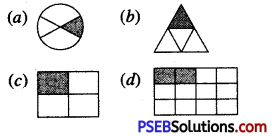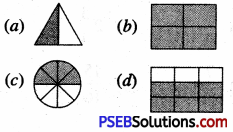Punjab State Board PSEB 6th Class Maths Book Solutions Chapter 5 Fractions MCQ Questions with Answers.
PSEB 6th Class Maths Chapter 5 Fractions MCQ Questions
Multiple Choice Questions
Question 1.
Which of the following does not represent any fraction?

Answer:

![]()
Question 2.
Which of the following is a proper fraction?
(a) \(\frac {5}{5}\)
(b) \(\frac {12}{11}\)
(c) \(\frac {7}{9}\)
(d) 7
Answer:
(c) \(\frac {7}{9}\)
Question 3.
Which of the following is an improper fraction?
(a) \(\frac {5}{8}\)
(b) \(2\frac {3}{4}\)
(c) \(\frac {7}{11}\)
(d) \(\frac {15}{16 }\)
Answer:
(b) \(2\frac {3}{4}\)
Question 4.
The fractions having las numerator are called …………. fractions.
(a) Like
(b) Unlike
(c) Unit
(d) Proper.
Answer:
(c) Unit
Question 5.
The fractions having same denominators are called …………. fractions.
(a) Proper
(b) Unit
(c) Improper
(d) Like.
Answer:
(d) Like.
Question 6.
The fraction having different denominators are called ……………. fractions.
(a) Unlike
(b) Like
(c) Improper
(d) Unit.
Answer:
(a) Unlike
![]()
Question 7.
Express 8 hours as a fraction of 1 day.
(a) \(\frac {2}{3}\)
(b) \(\frac {1}{3}\)
(c) \(\frac {8}{1}\)
(d) \(\frac {1}{8}\)
Answer:
(b) \(\frac {1}{3}\)
Question 8.
Find : \(\frac {2}{5}\) of ₹ 20.
(a) ₹ 8
(b) ₹ 10
(c) ₹ 12
(d) ₹ 40.
Answer:
(a) ₹ 8
Question 9.
Write \(\frac {19}{4}\) as mixed fraction.
(a) \(3\frac {4}{5}\)
(b) \(4\frac {4}{3}\)
(c) \(4\frac {3}{4}\)
(d) \(5\frac {1}{4}\)
Answer:
(c) \(4\frac {3}{4}\)
Question 10.
\(7\frac {2}{3}\) = ……………….
(a) \(\frac {17}{3}\)
(b) \(\frac {23}{3}\)
(c) \(\frac {13}{3}\)
(d) \(\frac {42}{3}\)
Answer:
(b) \(\frac {23}{3}\)
![]()
Question 11.
Which of the following represents an improper fraction?

Answer:

Question 12.
Which of the following is an equivalent of \(\frac {5}{7}\)?
(a) \(\frac {25}{49}\)
(b) \(\frac {20}{35}\)
(c) \(\frac {35}{49}\)
(d) \(\frac {35}{28}\)
Answer:
(c) \(\frac {35}{49}\)
Question 13.

(a) 32
(b) 24
(c) 40
(d) 16
Answer:
(a) 32
Question 14.
Which of the following are in ascending order?
(a) \(\frac{2}{3}, \frac{2}{7}, \frac{2}{5}\)
(b) \(\frac{2}{3}, \frac{2}{5}, \frac{2}{7}\)
(c) \(\frac{2}{7}, \frac{2}{3}, \frac{2}{5}\)
(d) \(\frac{2}{7}, \frac{2}{5}, \frac{2}{3}\)
Answer:
(d) \(\frac{2}{7}, \frac{2}{5}, \frac{2}{3}\)
![]()
Question 15.
Which of the following are in descending order?
(a) \(\frac{1}{8}, \frac{1}{3}, \frac{1}{9}\)
(b) \(\frac{1}{3}, \frac{1}{8}, \frac{1}{9}\)
(c) \(\frac{1}{8}, \frac{1}{9}, \frac{1}{3}\)
(d) \(\frac{1}{3}, \frac{1}{9}, \frac{1}{8}\)
Answer:
(b) \(\frac{1}{3}, \frac{1}{8}, \frac{1}{9}\)
Question 16.
\(\frac{4}{6}+\frac{3}{6}\) = …………. .
(a) \(\frac {7}{12}\)
(b) \(\frac {7}{8}\)
(c) \(1\frac {1}{6}\)
(d) \(1\frac {1}{12}\)
Answer:
(c) \(1\frac {1}{6}\)
Question 17.
\(\frac{4}{9}+\frac{5}{9}-\frac{2}{9}\) = ……………. .
(a) \(\frac {7}{9}\)
(b) \(\frac {7}{18}\)
(c) \(\frac {11}{9}\)
(d) \(\frac {5}{9}\)
Answer:
(a) \(\frac {7}{9}\)
Question 18.
\(\frac{2}{3}+\frac{1}{6}\) = ………………
(a) \(\frac {3}{9}\)
(b) \(\frac {5}{6}\)
(c) \(\frac {7}{6}\)
(d) \(\frac {5}{9}\)
Answer:
(b) \(\frac {5}{6}\)
![]()
Question 19.
4 – \(\frac {1}{3}\) = …………….
(a) \(4\frac {1}{3}\)
(b) \(3\frac {1}{3}\)
(c) \(4\frac {2}{3}\)
(d) \(3\frac {2}{3}\)
Answer:
(d) \(3\frac {2}{3}\)
Question 20.
Divide \(\frac {1}{6}\) by 2
(a) \(\frac {1}{3}\)
(b) \(\frac {1}{12}\)
(c) \(\frac {1}{18}\)
(d) 12
Answer:
(b) \(\frac {1}{12}\)
Question 21.
Which fraction is represented by point P on the adjoining number line?

(a) \(\frac {4}{5}\)
(b) \(\frac {5}{6}\)
(c) \(\frac {3}{4}\)
(d) \(\frac {3}{5}\)
Answer:
(a) \(\frac {4}{5}\)
Question 22.
Which fraction is represented by point P on the adjoining number line?

(a) \(\frac {1}{2}\)
(b) \(\frac {3}{5}\)
(c) \(\frac {4}{5}\)
(d) \(\frac {2}{5}\)
Answer:
(d) \(\frac {2}{5}\)
![]()
Question 23.
Which of the following fractions are in ascending order?
(a) \(\frac{1}{2}, \frac{1}{3}, \frac{1}{4}\)
(b) \(\frac{5}{10}, \frac{5}{11}, \frac{5}{12}\)
(c) \(\frac{1}{10}, \frac{1}{100}, \frac{1}{1000}\)
(d) \(\frac{3}{10}, \frac{4}{10}, \frac{7}{10}\)
Answer:
(d) \(\frac{3}{10}, \frac{4}{10}, \frac{7}{10}\)
Question 24.
Which of the following fractions are in descending order?
(a) \(\frac{1}{3}, \frac{1}{4}, \frac{1}{5}\)
(b) \(\frac{4}{11}, \frac{4}{12}, \frac{4}{13}\)
(c) \(\frac{1}{10}, \frac{1}{100}, \frac{1}{1000}\)
(d) \(\frac{7}{10}, \frac{9}{10}, \frac{11}{10}\)
Answer:
(a) \(\frac{1}{3}, \frac{1}{4}, \frac{1}{5}\)
Question 25.
Which of the following fraction is shown in the shaded portion of the figure?

(a) \(\frac {1}{3}\)
(b) \(\frac {2}{4}\)
(c) \(\frac {3}{4}\)
(d) \(\frac {2}{5}\)
Answer:
(b) \(\frac {2}{4}\)
Fill in the blanks:
Question (i)
The fraction shown in the shaded portion of the figure is ……………..,

Answer:
\(\frac {1}{4}\)
![]()
Question (ii)
The fraction of the shaded portion shown by the following figure is …………. .

Answer:
\(\frac {1}{8}\)
Question (iii)
The fraction of the shaded portion shown by the given figure is …………… .

Answer:
\(\frac {3}{7}\)
Question (iv)
The upper part of the fraction is called ……………. .
Answer:
numerator
Question (v)
The lower part of the fraction is called ……………. .
Answer:
denominator
Write True/False:
Question (i)
The fraction \(\frac {3}{5}\) is read as three fifth. (True/False)
Answer:
True
![]()
Question (ii)
The fraction whose numerator is less than the denominator is called the proper fraction. (True/False)
Answer:
True
Question (iii)
\(\frac {7}{8}\) is an improper fraction. (True/False)
Answer:
False
Question (iv)
Mixed fraction is a combination of a whole number and a proper fraction. (True/False)
Answer:
True
Question (v)
Fraction with the same denominator are called unlike fractions. (True/False)
Answer:
False
